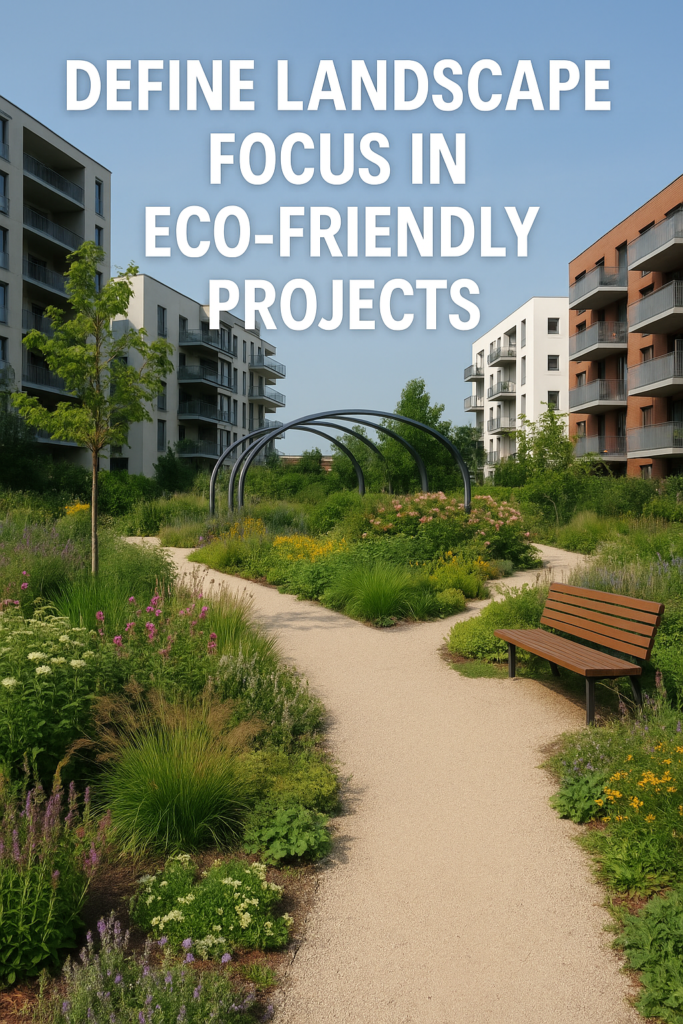Eco-friendly design has become a cornerstone of modern living, and outdoor environments are at the center of this movement. As architects, designers, and homeowners seek innovative solutions, the question arises: how do we define landscape within the context of sustainability and ecological responsibility?
Defining landscape in eco-friendly projects means more than planting a few trees or choosing drought-tolerant shrubs. It involves intentional design strategies that blend architecture, environmental stewardship, and lifestyle needs. From urban housing to smart cities, modern landscapes are being transformed into sustainable systems that benefit people, wildlife, and the planet.
Understanding What It Means to Define Landscape
To define landscape is to interpret outdoor spaces as interconnected systems rather than isolated features. In eco-friendly projects, this definition expands to include environmental conservation, energy efficiency, and community well-being.
The focus is not only on aesthetic beauty but also on reducing resource consumption, increasing biodiversity, and creating spaces that inspire human connection to nature. Gardens, rooftops, and public parks all play a role in shaping eco-conscious environments.
Core Principles of Eco-Friendly Landscape Focus
1. Native Plants and Biodiversity
Designers increasingly favor native plants that thrive in local conditions without excessive water or chemical inputs. Native plants also support pollinators, birds, and beneficial insects, restoring natural ecosystems in urban and suburban environments.
2. Water Conservation
Drought-resistant gardens, rainwater harvesting, and smart irrigation systems are essential features of eco-friendly projects. By designing for low water use, landscapes remain beautiful while protecting one of our most vital resources.
3. Renewable and Recycled Materials
Stone, reclaimed wood, recycled concrete, and permeable pavers provide durability while reducing environmental impact. These materials lower carbon footprints and support circular economy practices.
4. Energy Efficiency
The integration of shade trees, green roofs, and reflective paving reduces urban heat islands and lowers building energy consumption. These strategies combine landscaping with architectural performance.
Urban Housing: Defining Landscape for Compact Living
In dense urban environments, landscapes play a vital role in providing access to green spaces. Planners and architects now design compact yet impactful outdoor areas that prioritize wellness and sustainability.
Explore how professionals apply these principles in Define Landscape Ideas for Urban Housing. Small courtyards, vertical gardens, and rooftop retreats highlight how limited spaces can become eco-friendly sanctuaries. These strategies reduce stress, improve air quality, and foster community connections, proving that sustainability doesn’t require expansive land.
Smart Cities: Where Eco-Friendly Landscapes Meet Technology
As smart cities evolve, landscapes are being integrated with cutting-edge technology to balance urban growth with sustainability. Green corridors, smart irrigation systems, and climate-responsive plantings create adaptable, resilient outdoor spaces.
Learn more in Define Landscape Solutions in Smart Cities, which explores how cities are embedding ecological landscapes into digital planning systems. These eco-friendly solutions go beyond beautification; they actively contribute to cooling, carbon absorption, and energy reduction.
Outdoor Harmony: Balancing Nature and Design
Eco-friendly projects are not just about sustainability metrics—they also strive to create spaces where people feel at peace. Balancing hardscapes, vegetation, and architectural elements ensures outdoor environments are both functional and soothing.
The integration of artistic features, water elements, and native planting contributes to this balance. For inspiration, see Define Landscape Harmony in Outdoor Design, where designers show how harmonious landscapes enhance both ecological systems and human well-being.
The Role of Energy-Efficient Building Materials
Sustainable landscapes often go hand in hand with energy-conscious construction. For example, glass plays an important role in reducing heating and cooling demands.
Architects looking to merge indoor and outdoor spaces can reference Insulating Glass Unit Selection Tips for Architects, which emphasizes choosing materials that optimize energy efficiency. When paired with eco-friendly landscape strategies, these glass systems create environments that are visually striking and environmentally responsible.
Case Studies: Eco-Friendly Landscape Applications
Residential Projects
- Rooftop gardens that capture rainwater and provide insulation.
- Vertical plant walls that filter urban air pollution.
- Shared green courtyards that build community and reduce stormwater runoff.
Commercial Developments
- Corporate campuses with pollinator gardens and native meadows.
- Energy-efficient parking areas with permeable paving.
- Smart lighting integrated into landscapes for safety and efficiency.
Public Spaces
- Community parks with drought-tolerant plant palettes.
- Green corridors linking neighborhoods with walkable, shaded paths.
- Urban forests designed to combat air pollution and provide natural cooling.
Why Eco-Friendly Landscape Focus Matters in 2025
The shift toward sustainable landscapes reflects broader changes in how we live and build in a climate-conscious world. Eco-friendly design is no longer optional—it is a necessity.
By prioritizing eco-conscious landscapes, we not only redefine outdoor beauty but also secure healthier, more resilient communities. Architects, designers, and homeowners who embrace these principles are paving the way for a sustainable future where every landscape contributes to ecological well-being.
Final Thoughts
To define landscape in eco-friendly projects is to merge design artistry with environmental responsibility. From urban housing to smart cities, the integration of sustainable practices ensures outdoor spaces are not only visually appealing but also beneficial for the planet.
By embracing native plants, water conservation, energy-efficient materials, and harmonious design, we create landscapes that respond to today’s environmental challenges while inspiring future generations.
Eco-friendly landscapes are more than trends—they are the blueprint for sustainable living.

